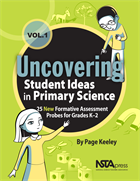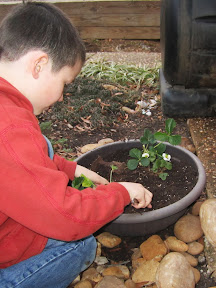Argumentation–respectfully disagreeing when making a scientific claim
By Peggy Ashbrook
Posted on 2013-07-19
Is there an age at which we can expect children to understand that disagreement can be about an idea—not a personal statement of dislike—that they can have a different opinion and still “be friends?” Dr. Amelia Church, Lecturer in Master of Teaching (Early Childhood) at the University of Melbourne, finds that “the four-year-olds I worked with do not necessarily hear opposition as ‘dislike’. In fact, the further away from personal objections reasons for opposition are, the more likely they are to be persuasive (eg “because that wasn’t a block, it was a cylinder” meets with acquiescence). Conflict is not necessarily a threat to friendship. From a young age children can see that the problem lies with what they are doing rather than who they are.”
 The summer 2013 issue in this 50th year of publication of Science and Children, focuses on argumentation in science, one of the eight science and engineering practices described by the Framework as “essential for learning science and engineering in grades K-12” (NRC, pg 41). In the free article, “Developing a Scientific Argument: Modeling and practice help students build skills in oral and written discourse” by Lori Fulton and Emily Poeltler, we see how second graders developed their argumentation skills going far beyond, “uh-uh” and “uh-huh”, and, “is too” and “is not.” With support for understanding that a discussion of ideas is not a personal attack, talking to each other rather than the teacher, and practice using sentence starters or frames, the second grade class began to use evidence to support their ideas and to disagree with others. I’ve observed this type of discussion introduced in both kindergarten and first grade classes where they were making progress towards using it smoothly.
The summer 2013 issue in this 50th year of publication of Science and Children, focuses on argumentation in science, one of the eight science and engineering practices described by the Framework as “essential for learning science and engineering in grades K-12” (NRC, pg 41). In the free article, “Developing a Scientific Argument: Modeling and practice help students build skills in oral and written discourse” by Lori Fulton and Emily Poeltler, we see how second graders developed their argumentation skills going far beyond, “uh-uh” and “uh-huh”, and, “is too” and “is not.” With support for understanding that a discussion of ideas is not a personal attack, talking to each other rather than the teacher, and practice using sentence starters or frames, the second grade class began to use evidence to support their ideas and to disagree with others. I’ve observed this type of discussion introduced in both kindergarten and first grade classes where they were making progress towards using it smoothly.
 “Science talk” is the format for using the formative assessment probes in Page Keeley’s Uncovering Student Ideas in Primary Science Vol. 1 (2013). Each “probe” is a picture and a question designed to prompt student thinking and discussion so teachers can find out students’ ideas (including misconceptions.) She recommends reading Ready, Set, Science! Putting Research to Work in K-8 Classrooms (Michaels, Shouse and Schweingruber 2008), especially Chapter 5, “Making Thinking Visible: Talk and Argument.” (Ready, Set, Science! is a free download from the National Academy Press.) Keeley further describes the use of the six “talk moves” from Ready, Set, Science! which teachers can use to help students clarify and expand their reasoning and arguments.
“Science talk” is the format for using the formative assessment probes in Page Keeley’s Uncovering Student Ideas in Primary Science Vol. 1 (2013). Each “probe” is a picture and a question designed to prompt student thinking and discussion so teachers can find out students’ ideas (including misconceptions.) She recommends reading Ready, Set, Science! Putting Research to Work in K-8 Classrooms (Michaels, Shouse and Schweingruber 2008), especially Chapter 5, “Making Thinking Visible: Talk and Argument.” (Ready, Set, Science! is a free download from the National Academy Press.) Keeley further describes the use of the six “talk moves” from Ready, Set, Science! which teachers can use to help students clarify and expand their reasoning and arguments.

In The Early Years column, “Pondering Strawberries,” I wrote about activities that can be part of an inquiry into how plants reproduce, or make baby plants. There are many opportunities for scientific argumentation, to express ideas and the evidence to support them, when investigating plants. “Are seeds alive?” and “Do all plants grow from seeds?” are two questions that may be part of such an inquiry. Strawberry plants are interesting because, like the houseplant “Spider plant,” they grow new plants on the ends of runners (stolons) in addition to growing from seed. Children like to eat strawberries and varieties can grow in much of the continental United States (USDA Plant Hardiness Zones 3-8).
When planted in the fall, young strawberry plants may become well established by spring and bear fruit. Do you have a large pot or garden space for a few strawberry plants? (See a short list of resources for growing strawberries at the end of this post.)
Before children can argue with evidence for their ideas in science, the culture of the classroom must support this. In discussion groups, I tell my young students that scientists may have ideas that are different from other scientists, and that’s okay. I encourage them to say what they think and why they think that.
Fascinatingly, whole books are written about how young children argue and the meaning of it. Argumentation is an important part of learning math concepts as children explain their reasoning in solving problems. The processes used in establishing productive discussion in science are similar to those used by teachers in establishing a safe, productive environment for learning mathematics.
Australian researchers, Bob Perry, Sue Dockett and Elspeth Harley describe “argumentation” as one of the powerful mathematical ideas, “the process that allows children to justify their own mathematical thinking and to understand that of other people” (Perry 2007). The authors recognize that providing justification for thinking is also important in other areas of learning. See the numeracy matrix they developed with others to be used to reflect on one’s practice of teaching mathematics and supporting children as they develop. The matrix uses questions to help early childhood educators reflect on what practices they are using to teach mathematical ideas and in helping children develop Developmental Learning Outcomes, such as, “Children develop trust and confidence.” I can see how these questions can be very helpful. The authors describe the numeracy matrix as, by its very nature, a work in progress.
In another article in the Summer 2013 issue of Science and Children, “Using Language Positively: How to encourage negotiation in the classroom,” authors Emily Schoerning and Brian Hand recommend using the term “negotiation” to replace “argument.” They point out that in a negotiation, people work together, people are not verbally attacked, and nobody wins. They offer specific listening and speaking tips for negotiation in the classroom, and note that “Students come to the science classroom with different levels of familiarity with formal argumentation, but all of them find it easier to learn and grow in environments that are not threatening.”
Searching for “argument,” in the archives of the NAEYC journal Young Children, I found one article with discussion of arguments among children, “Assessing and Scaffolding Make-Believe Play” by Deborah J. Leong and Elena Bodrova in the January 2013 issue, none for “argumentative” and none for “argumentation.” Discussions between children are noted as part of the science learning described in Spotlight on Young Children: Exploring Science (NAEYC 2013). Suggested strategies for promoting inquiry-based learning in the classroom are similar to Schoerning and Hand’s speaking and listening tips for establishing negotiation in the classroom. Authors encourage teachers to use questions, similar to the numeracy matrix, to create a classroom where children are encouraged to develop and maintain respectful relationships even though they may not agree with others’ ideas, and to contribute constructively to discussions and arguments.
Listen to Cathy Fink and Marcy Marxer’s rendition of Bill Harley’s “Is Not Is Too” for an example of arguing, familiar to us all, that is unproductive for science but helps children develop social skills. And reflect on what classroom practices you have to support productive argumentation.
[youtube]http://www.youtube.com/watch?v=DDIB4MJkQNs[/youtube]
~~~~~~~~~~~~~~~~~~~~~~~~~~~~~~~~~~~~~~~~~~~~~~~~~~~~~~~~~~~~~~~~~~~~~~~~~~~~~
Church, Amelia. 2009. Preference Organisation and Peer Disputes: How Young Children Resolve Conflict. University of Melbourne, Australia (Ashgate Publishing Limited). http://www.ashgate.com/isbn/9780754674412
Keeley, Page. 2013. Uncovering Student Ideas in Primary Science: 25 New Formative Assessment Probes for Grades K-2, Vol. 1. Arlington, VA: National Science Teachers Association.
Leong Deborah J., and Elena Bodrova. 2013. Assessing and Scaffolding Make-Believe Play. Young Children. 67 (1): 28-34.
Michaels, Sarah, and Andrew W. Shouse, Heidi A. Schweingruber. 2008. Ready, Set, Science! Putting Research to Work in K-8 Classrooms. Washington, DC: National Academies Press. http://www.nap.edu/catalog.php?record_id=11882
National Research Council (NRC). 2012. A framework for K–12 science education: Practices, crosscutting concepts, and core ideas. Washington, DC: National Academies Press. http://www.nap.edu/catalog.php?record_id=13165
Perry, Bob and Sue Dockett and Elspeth Harley. 2007. Learning Stories and Children’s Powerful Mathematics. Early Childhood Research and Practice, Volume 9 Number 2. http://ecrp.uiuc.edu/v9n2/perry.html
Schoerning, Emily and Brian Hand. 2013. Using Language Positively: How to encourage negotiation in the classroom. Science and Children. 50 (9): 42-45
~~~~~~~~~~~~~~~~~~~~~~~~~~~~~~~~~~~~~~~~~~~~~~~~~~~~~~~~~~~~~~~~~~~~~~~~~~~~
Resources for growing plants with stolons:
Smith, Brian R, and D. Mahr, P. McManus, and T. Roper.1999. Growing Strawberries in Wisconsin. Madison, WI: Cooperative Extension of the University of Wisconsin-Extension. http://milwaukee.uwex.edu/files/2010/05/GrowingStrawberriesA1597.pdf
StrawberryPlants.org. When to plant strawberries, growing from seed and other topics. http://strawberryplants.org/2011/04/strawberry-planting-guide/
DoItYourSelf.com, Practical tips on growing spider plants. http://www.doityourself.com/stry/spiderplants#.UTjHHBysiSo
Disclaimer: The views expressed in this blog post are those of the author(s) and do not necessarily reflect the official position of the National Science Teaching Association (NSTA).


